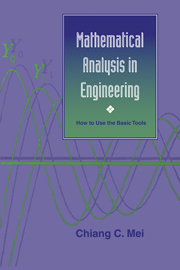Book contents
- Frontmatter
- Contents
- Preface
- Acknowledgments
- 1 Formulation of physical problems
- 2 Classification of equations with two independent variables
- 3 One-dimensional waves
- 4 Finite domains and separation of variables
- 5 Elements of Fourier series
- 6 Introduction to Green's functions
- 7 Unbounded domains and Fourier transforms
- 8 Bessel functions and circular boundaries
- 9 Complex variables
- 10 Laplace transform and initial value problems
- 11 Conformal mapping and hydrodynamics
- 12 Riemann–Hilbert problems in hydrodynamics and elasticity
- 13 Perturbation methods – the art of approximation
- 14 Computer algebra for perturbation analysis
- Appendices
- Bibliography
- Index
13 - Perturbation methods – the art of approximation
Published online by Cambridge University Press: 05 June 2012
- Frontmatter
- Contents
- Preface
- Acknowledgments
- 1 Formulation of physical problems
- 2 Classification of equations with two independent variables
- 3 One-dimensional waves
- 4 Finite domains and separation of variables
- 5 Elements of Fourier series
- 6 Introduction to Green's functions
- 7 Unbounded domains and Fourier transforms
- 8 Bessel functions and circular boundaries
- 9 Complex variables
- 10 Laplace transform and initial value problems
- 11 Conformal mapping and hydrodynamics
- 12 Riemann–Hilbert problems in hydrodynamics and elasticity
- 13 Perturbation methods – the art of approximation
- 14 Computer algebra for perturbation analysis
- Appendices
- Bibliography
- Index
Summary
Introduction
In previous chapters we have only discussed techniques of getting exact solutions. Clearly, the problems must be sufficiently idealized for these techniques to be effective. For more practical problems either the boundary geometry or the governing equations are less simple, and one must often be content with approximate solutions. Among methods of approximation two are the most important. If the problem is close to one that is solvable exactly, perturbation methods are powerful tools for getting analytical answers. If, however, the problem is far from anything that can be solved exactly, strictly numerical methods via discretization must be employed. In general, analytical perturbation methods are much more effective in gaining qualitative insight, while numerical methods are good in producing quantitative information. Sometimes the two can be mixed for studying small departures from a basic state that must itself be solved numerically.
In this chapter we shall give an introductory account of the analytical approach of perturbation methods. To have a bird's-eye view of the subject, let us first outline the typical ideas and procedure of a perturbation analysis.
(i) Identify a small parameter. This is a very important first step which must be taken by recognizing the physical scales relevant to the problem. One then normalizes all variables with respect to these characteristic scales. In the normalized form, the governing equations will display certain dimensionless parameters, each of which represents the relative importance of certain physical mechanisms.
- Type
- Chapter
- Information
- Mathematical Analysis in EngineeringHow to Use the Basic Tools, pp. 343 - 407Publisher: Cambridge University PressPrint publication year: 1995



